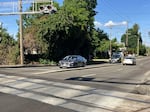A multi-million-dollar initiative to create a “quiet zone” for downtown Eugene’s railroad crossings appears to be tangled up in a sea of red tape.

A Union Pacific train passes through the High Street crossing on May 30, 2025. As required by law, this train and all others must sound their horns at designated crossings to alert traffic and pedestrians to their presence.
Brian Bull / KLCC
Two years ago, you’d hear a shrill and bellowing horn any time a train coursed through the city.
But today, listening at any of the downtown crossings, you can expect to hear…a shrill and bellowing horn as a train courses through the city.
What happened?
Well…nothing.
The original initiative, launched in 2015, was to reconstruct ten crossings to make them safer for pedestrians and traffic, and largely eliminate the blaring train horns that have been the bane of many Eugene businesses and residents. In 2018, a project manager for the city told KLCC it would take about three years to implement. Five years later, in 2023, the city was predicting that construction could start as soon as 2025. But by the end of May, work on the project was still not imminent.
So why has the project chugged to a halt?
“The current holdup is that we need access to Union Pacific’s property in order to do that construction, and that permission has not been granted,” said Marion Barnes with the City of Eugene’s Public Works department.
Barnes said the city is working with the Oregon Department of Transportation, which issued a crossing order more than two years ago, to get the quiet zone project back on track.
In an email to KLCC, Union Pacific said the company is working with the City of Eugene to refine their latest engineering plan. Once finalized to meet federal standards for a railroad quiet zone, the company will grant construction crews access to the crossings. This would ultimately lead to final federal approval.
Barnes said that she’s hopeful, but not getting her hopes up.
“Once we do the construction, then we can reach out to the federal agency and get that application for a railroad quiet zone in,” she said. “Now, as we know, the federal government’s in something of disarray at the moment, so I’m not sure if that’ll be a factor or not, but you know we’re just going to try to keep our heads down and be ready for the next step. When we’re able to move forward, we’re gonna jump on it.”
Between the speed of bureaucracy and the upheavals happening with the federal government, Barnes offered no set timelines for the project’s completion. And the City of Eugene will try to keep the project between its original $7 million to $10 million price tag.
An unwelcome symphony
The only real guarantee for now is that the sound of train horns blasting at every downtown crossing will remain constant for the foreseeable future. That discourages some prospective business owners.
“During an acupuncture treatment, we have white noise and music, but as you know if you’re anywhere within proximity, that’s not going to drown it out,” said Christina Crawford. She’s been hoping to relocate her business, Crawford Acupuncture, from Albany, NY to Eugene. It’s a city she and her husband love for its bike paths, hiking trails, and culture.
“I was just so excited when they had first started talking about implementing the quiet zone,” Crawford recalled. “I was like, ‘Alright, now we can start looking forward to building that foundation and that future!’ and that’s not going to happen at this point in time.”
Crawford says now they’re setting their sights on Salem, a city that successfully created a quiet zone more than a decade ago.

A railroad quiet zone in Salem, seen on May 29, 2025, includes raised concrete medians designed to prevent drivers from going around downed gates.
Chris Lehman / KLCC
Meanwhile, Union Pacific said the City of Eugene hired an engineering firm last year, which has improved the process.
And Marion Barnes of the city’s public works department said they’re also trying to make gains with the railroad on yet another big project: the seismic upgrade of the bridge at Chambers and Roosevelt.
Copyright 2025, KLCC.
Brian Bull is a reporter with KLCC. This story comes to you from the Northwest News Network, a collaboration between public media organizations in Oregon and Washington.
It is part of OPB’s broader effort to ensure that everyone in our region has access to quality journalism that informs, entertains and enriches their lives. To learn more, visit our journalism partnerships page.